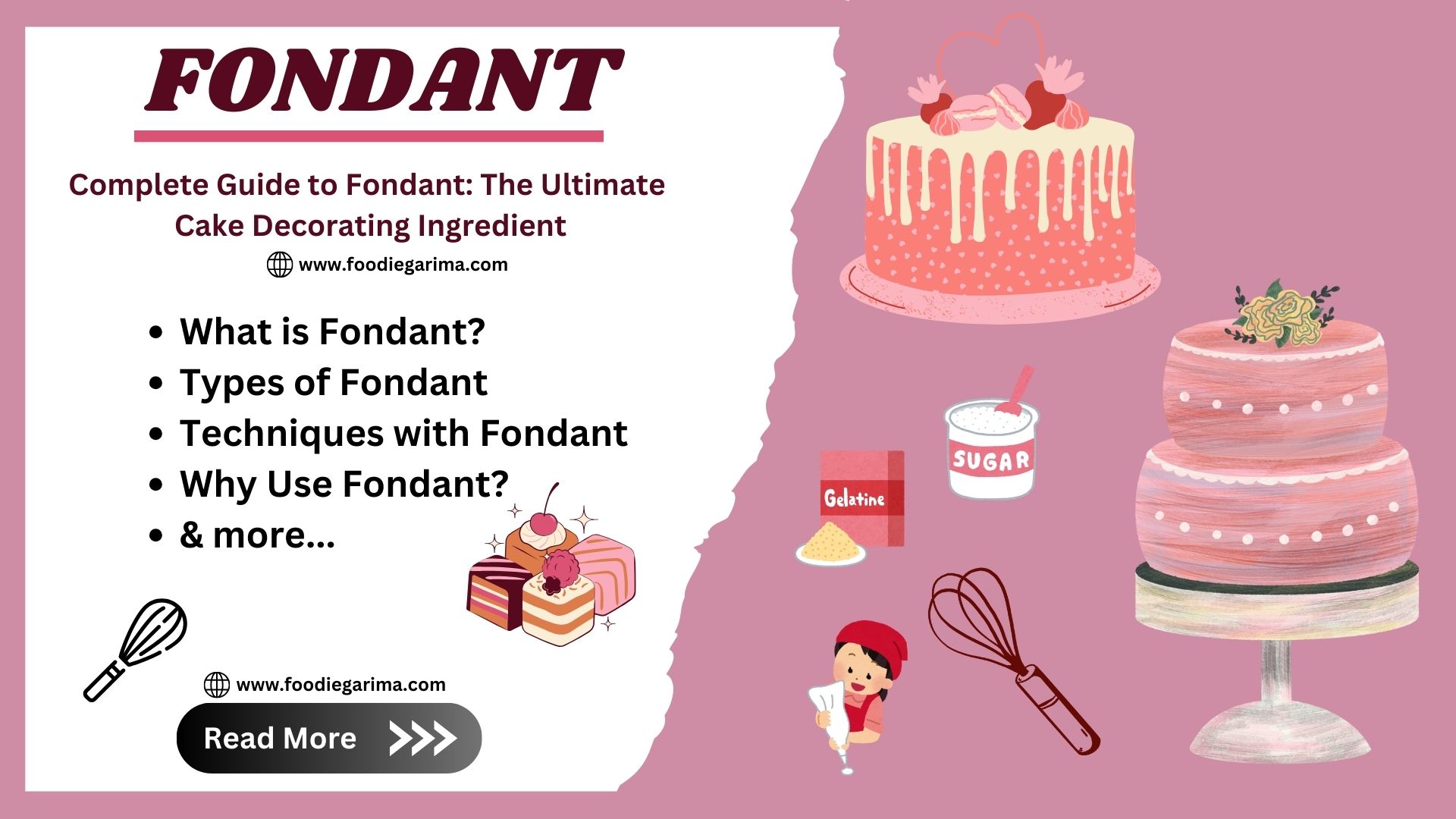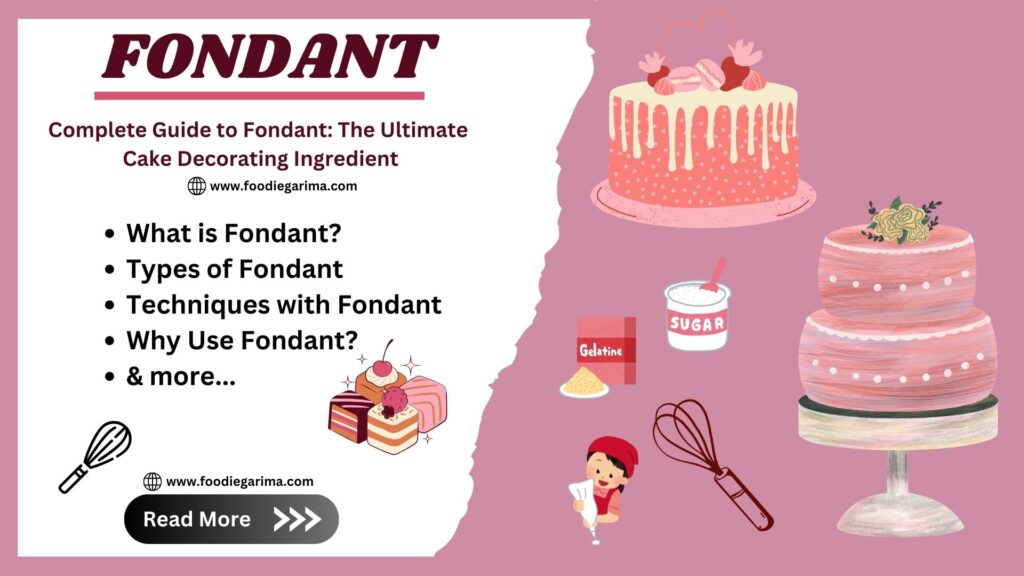11 January, 2025
Fondant: The Ultimate Cake Decorating Ingredient

Fondant Cakes, Fondant Icing
Complete Guide to Fondant: The Ultimate Cake Decorating Ingredient
Fondant is the secret behind many of the smooth, polished cakes and intricate sugar decorations that wow at weddings, birthdays, and special events. But what exactly is Fondant, and how is it used in cake decorating?
In this article, we’ll explore what Fondant is, the different types, how to make it at home, and tips for working with it. Whether you’re a novice baker or an experienced cake decorator, this guide will help you master the art of Fondant.
What is Fondant?
Fondant is a type of icing made from Sugar, Water, and other ingredients that give it a smooth, pliable texture. Its main appeal lies in its ability to cover cakes seamlessly, providing a perfect, glossy finish. Fondant can also be molded into decorations like flowers, figurines, and bows, making it a favorite among cake decorators for its versatility.
The term “Fondant” comes from the French word fondre, meaning “to melt,” which is a fitting description given its smooth, melt-in-your-mouth texture. Though Fondant is most often used for covering cakes, it’s also used in candy making, as a filling for chocolates, or even as a glaze for petit fours.
Types of Fondant
There are two primary types of Fondant used in cake decorating: Rolled Fondant and Poured Fondant. Each serves a different purpose and has unique characteristics.
1. Rolled Fondant
Rolled Fondant is the type most commonly used for covering cakes and creating detailed decorations. It’s a thick, dough-like consistency (or modelling clay like) that you roll out into a flat sheet to drape over cakes. Once applied, it creates a smooth, flawless appearance that can be customised with colors and textures.
How it’s used:
- Cake covering: Rolled Fondant is used to cover cakes, providing a smooth surface for decorating.
- Decorations: Rolled Fondant can be shaped into flowers, bows, ribbons, figurines, and other decorations to adorn cakes.
2. Poured Fondant
Poured Fondant has a thinner, more liquid consistency than Rolled Fondant. It’s commonly used to glaze cakes or to coat smaller pastries like petit fours. It can also be used as a filling for chocolates, providing a smooth and creamy center.
How it’s used:
- Glazing: Poured Fondant is poured over cakes or pastries to create a glossy, smooth finish.
- Chocolate filling: It’s used as a soft, sweet center in confections like chocolate truffles.
Other Types
Sculpting Fondant
Thicker and more elastic, sculpting fondant is perfect for crafting intricate cake toppers.
Marshmallow Fondant
Ingredients: Marshmallows, powdered sugar, and water.
Steps: Melt marshmallows, mix with sugar, and knead to achieve a pliable texture.
Sugar Paste
It is a type of Fondant that is often used interchangeably with “Rolled Fondant,” though technically, it’s slightly different in composition and texture.
Sugar Paste vs. Rolled Fondant
While Sugar Paste and Rolled Fondant are often used interchangeably, there are subtle differences between them:
- Texture: Sugar Paste is usually firmer and more elastic than Rolled Fondant. This makes it better for creating detailed, small decorations (like flowers) because it holds its shape more easily. Rolled fondant, on the other hand, is softer and more pliable, making it easier to cover large cakes with a smooth surface.
- Drying Time: Sugar Paste tends to dry faster and harder than Rolled Fondant. This is especially important when making decorations that need to maintain their shape for long periods, such as flowers and figurines.
- Workability: Sugar Paste is ideal for fine details, as it holds its shape when dried, unlike Rolled Fondant, which is usually softer and may need additional support for intricate designs.
- Use: While Rolled Fondant is the preferred choice for covering cakes, Sugar Paste is preferred for decorative work that requires finer details and for flowers or figurines that need to set hard.
How Fondant is Made
While you can buy Fondant pre-made from cake supply stores, making it at home is a rewarding (and often cost-effective) option. Below are the basic recipes for both rolled and poured fondant.
Rolled Fondant Recipe
Ingredients:
- 1 lb (about 4 cups) powdered sugar
- 1 tablespoon unflavored gelatin
- 1/4 cup cold water
- 1/4 cup glucose syrup or light corn syrup
- 1 tablespoon glycerin (optional, for pliability)
- 1 teaspoon vanilla extract (optional)
- Vegetable shortening (for greasing)
Method:
- Dissolve Gelatin:
- Sprinkle the gelatin over the cold water and let it sit for 5-10 minutes to bloom (absorb the water).
- After the gelatin has bloomed, gently heat it (either in a microwave or over a double boiler) until it melts and becomes liquid. Be careful not to overheat.
- Combine Syrups:
- Add the glucose syrup (or corn syrup) to the melted gelatin mixture. Stir in glycerin and any flavoring, such as vanilla or almond extract. This mixture will help make the fondant smoother and more pliable.
- Mix with Powdered Sugar:
- Place the powdered sugar in a large mixing bowl or on a clean surface. Make a well in the center and pour the liquid mixture into it.
- Stir it together until it begins to form a dough. Once it starts to come together, knead the fondant on a clean surface lightly dusted with powdered sugar.
- Knead:
- Knead the fondant for 5-10 minutes until it’s smooth and elastic. If it feels too sticky, add a little more powdered sugar. If it’s too dry, add a tiny bit of water or shortening.
- Rest and Store:
- Wrap the fondant in plastic wrap and place it in an airtight container. Let it rest for at least an hour before using. It can be stored at room temperature for a couple of weeks or refrigerated for longer storage.
Poured Fondant Recipe
Ingredients:
- 2 cups granulated sugar
- 1/2 cup water
- 1/4 cup light corn syrup
- 1 teaspoon vanilla extract (optional)
Method:
- Combine ingredients and Cook:
- Combine the sugar, water, and corn syrup in a saucepan. Heat over medium-high heat, stirring occasionally, until the sugar dissolves.
- Boil:
- Bring the mixture to a boil, and continue boiling without stirring until the temperature reaches about 240°F (115°C) on a candy thermometer.
- Cool and Add Flavor:
- Remove from heat and allow it to cool slightly (to around 100°F or 38°C). Stir in the vanilla extract if desired.
- Pour Over Cake:
- Once it cools to a pourable consistency, you can use it to glaze cakes or coat other pastries. Let it set at room temperature for a smooth, glossy finish.
Tips for Working with Fondant
Fondant can be a little tricky to work with, especially for beginners, but with a few helpful tips, you can get the results you want:
- Keep fondant covered: Fondant dries out quickly, so it’s important to keep it tightly wrapped in plastic wrap when not in use.
- Use shortening for smoothness: If your fondant is too sticky to work with, lightly grease your hands and rolling surface with vegetable shortening instead of powdered sugar. This will prevent the fondant from drying out or becoming too sugary.
- Rolling out fondant: To avoid sticking, dust your work surface and rolling pin with powdered sugar or cornstarch before rolling out the fondant. Aim for a thickness of about 1/8 inch.
- Coloring fondant: If you want to color your fondant, use gel food coloring rather than liquid food coloring. Gel colors are more concentrated and won’t affect the consistency of the fondant. Add the color while kneading to ensure an even color throughout.
- Patch up cracks: If you notice small cracks or imperfections in your fondant after applying it to a cake, you can smooth them out by gently massaging the fondant with your hands. If that doesn’t work, a warm, damp cloth can help soften the fondant for easier smoothing.
- Store fondant properly: If you have leftover fondant, store it in an airtight container or wrap it tightly in plastic wrap to keep it from drying out. It can be stored at room temperature for up to a few weeks, or in the refrigerator for longer storage.
Essential Tools for Working with Fondant
To work seamlessly with fondant, you’ll need:
- Rolling Pins and Mats: Ensure even thickness.
- Fondant Smoothers: Achieve a sleek finish.
- Shaping and Cutting Tools: Create intricate designs with ease.
Decorating Techniques with Fondant
Cutouts and Appliqué
Use cookie cutters for simple shapes or layer fondant for a 3D effect.
Embossing and Stenciling
Add patterns using embossing tools or stencils for a professional touch.
Creating Fondant Figures
Bring cakes to life with whimsical characters and designs
Creative Ideas for Fondant Decorations
Explore themes like:
- Spring blossoms for seasonal cakes
- Elegant lace for weddings
- Cartoon characters for kids’ parties
Why Use Fondant?
Fondant is popular among cake decorators for several reasons:
- Smooth finish: Fondant creates a flawless, polished appearance on cakes that is hard to achieve with buttercream alone.
- Versatility: It can be shaped into intricate decorations, making it perfect for creating detailed flowers, figurines, and other edible art.
- Stability: Once set, fondant holds its shape, which makes it ideal for creating three-dimensional decorations that will stay intact for hours.
- Longer shelf life: Fondant-covered cakes tend to last longer than those covered with buttercream, as fondant helps seal in moisture.
Whether you’re covering a cake, creating stunning decorations, or glazing pastries, Fondant is a key ingredient in cake decorating that can elevate the look and feel of your creations. While working with Fondant may take some practice, the results are well worth the effort. By making your own Fondant at home or purchasing it ready-made, you can take your cake decorating skills to the next level and create beautiful, professional-looking treats for any occasion.
FAQs
1. Can fondant be refrigerated?
Yes, but bring it to room temperature before working with it to avoid condensation.
2. Can I use fondant on cupcakes?
Absolutely! Fondant adds an elegant touch to cupcakes.
3. Is fondant edible?
Yes, although its sugary taste may not appeal to everyone.
4. How do I fix dried fondant?
Knead in a small amount of shortening or glycerin to restore its softness.
